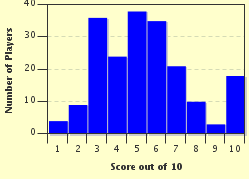Quiz Answer Key and Fun Facts
1. What type of skeleton do humans and most vertebrates have?
2. Cats are more flexible and agile than humans, partly because they have fewer vertebrae (bones in the spine).
3. Sesamoid bones are found in joints. Which of the following is NOT a sesamoid bone?
4. The tailbone gets its scientific name (coccyx) from a Greek word. What does coccyx mean?
5. Which of the following wrist bones is the first one to form?
6. Which of the following bone-related diseases does NOT target primarily large breeds of dogs?
7. The finger bones are split into three categories, the distal, intermediate and proximal phalanges. Given that the intermediate are in the middle, which category is closest to the tip of the fingers?
8. Most birds have hollow bones in order to be able to fly. What is the phenomenon of having air in the bones called?
9. The sacrum is a large bone. Where is it located in the human body?
10. Which of the following statements about the skeletal structure of the dolphin is true?
Source: Author
Gil_Galad
This quiz was reviewed by FunTrivia editor
CellarDoor before going online.
Any errors found in FunTrivia content are routinely corrected through our feedback system.

